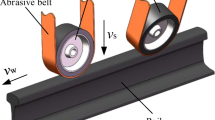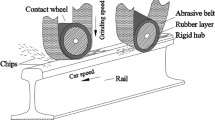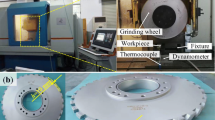Abstract
To understand intuitively the residual stress state on the rail surface after abrasive belt rail grinding (ABRG), the influences of grinding process parameters on residual stress were experimentally investigated on the ABRG test bench. Tensile residual stress was found in the grinding direction, while the residual stress in the radial direction was maintained mainly in the form of compressive stress. To investigate the mechanisms of the influencing factors during the forming process of residual stress, a 3D finite element model (FEM) of grain scratching based on thermo-mechanical coupling method was developed. Effects of contact surface friction, grain’s tip radius, grain’s protrusion depth, and grain’s rake angle on residual stress distribution in rail sub-layer were revealed, respectively. In addition, the FEM simulation of residual stress involving adjacent grains scratching was carried out, in which the variation of the residual stress field between the on scratching and the subsequent scratching was observed and discussed. Finally, the suggestions for the design of the last grinding unit and grinding process parameter selection were given based on the findings from the experiment and simulation.























Similar content being viewed by others
References
Cannon DF, Edel KO, Grassie SL, Sawley K (2003) Rail defects: an overview. Fatigue Fract Eng M 26(10):865–886
Magel EE, Kalousek J (2002) The application of contact mechanics to rail profile design and rail grinding. Wear 253(1–2):308–316
Liu YM, Yang TY, He Z, Li JY (2018) Analytical modeling of grinding process in rail profile correction considering grinding pattern. Arch Civ Mech Eng 18(2):669–678
Wang WX, Li JY, Fan WG (2019) Investigation into static contact behavior in belt rail grinding using a concave contact wheel. Int J Adv Manuf Tech 101(9–12):2825–2835
Fan WG, Liu YM, Song XY, Cheng JF, Li JY (2018) Influencing mechanism of rubber wheel on contact pressure and metal removal in corrugated rail grinding by abrasive belt. J Manuf Sci E-T Asme 140(12):124501
He Z, Li JY, Liu YM, Nie M, Fan WG (2017) Investigating the effects of contact pressure on rail material abrasive belt grinding performance. Int J Adv Manuf Tech 93(1–4):779–786
He Z, Li JY, Liu YM, Yan JW (2019) Investigation on wear modes and mechanisms of abrasive belts in grinding of U71Mn steel. Int J Adv Manuf Tech 101(5–8):1821–1835
Cheng C, Li JY, Liu YM, Nie M, Wang WX (2019) Deep convolutional neural network-based in-process tool condition monitoring in abrasive belt grinding. Comput Ind 106:1–13
Xiao GJ, He Y, Huang Y, Li Q (2019) Shark-skin-inspired micro-riblets forming mechanism of TC17 titanium alloy with belt grinding. Ieee Access 7:107635–107647
Wang WX, Salvatore F, Rech J, Li JY (2018) Comprehensive investigation on mechanisms of dry belt grinding on AISI52100 hardened steel. Tribol Int 121:310–320
Wang WX, Salvatore F, Rech J, Li JY (2018) Investigating effects of adhesion wear on cutting efficiency and energy cost in dry belt finishing. Int J Adv Manuf Tech 95(5–8):2119–2123
Schleinzer G, Fischer FD (2001) Residual stress formation during the roller straightening of railway rails. Int J Mech Sci 43(10):2281–2295
Ringsberg JW, Bjarnehed H, Johansson A, Josefson BL (2000) Rolling contact fatigue of rails - finite element modelling of residual stresses, strains and crack initiation. Proc Inst Mech Eng Part F-J Rail Rapid Transit 214(1):7–19. https://doi.org/10.1243/0954409001531207
Smith RA (2002) Rolling contact fatigue of rails :what remains to be done ? China Railway Science 03:8–12
Li Y (2017) Study on the effect of residual stress on fatigue crack initiation and propagation of rail. Master Thesis, Shijiazhuang Tiedao University, Hebei, China
Garcia Navas V, Ferreres I, Maranon JA, Garcia-Rosales C, Gil Sevillano J (2008) Electro-discharge machining (EDM) versus hard turning and grinding - comparison of residual stresses and surface integrity generated in AISI O1 tool steel. J Mater Process Technol 195(1–3):186–194. https://doi.org/10.1016/j.jmatprotec.2007.04.131
Zhou QY, Zhang YH, Tian CH, Chen ZY, Liu FS, Yu Z, Li L (2014) Profile design and test study of 60N rail. China Railway Science 35(02):128–135
Wang JW, Xu JJ, Wang XF, Zhang XQ, Song XF, Chen XQ (2019) A comprehensive study on surface integrity of nickel-based superalloy Inconel 718 under robotic belt grinding. Mater Manuf Process 34(1):61–69
Fan WG, Liu YM, Wang WX, Li JY, Wang RQ (2018) Research on modeling method of material removal for rail grinding by abrasive belt based on elastic Hertzian contact. J Mech Eng 54(15):191–198
Rech J, Kermouche G, Grzesik W, Garcia-Rosales C, Khellouki A, Garcia-Navas V (2008) Characterization and modelling of the residual stresses induced by belt finishing on a AISI52100 hardened steel. J Mater Process Technol 208(1–3):187–195. https://doi.org/10.1016/j.jmatprotec.2007.12.133
Deng ZH, Liu G, Liu LX, Luo CC, Qin YZ, Xu SL (1995) Study on residual stress in surface layer of powerful belt surface grinding. J Hunan Univ 06:65–69
Huang Y, Jiahua SL, Xiao GJ, He Y, Dai WT, He S, Li W (2020) Study on the surface topography of the vibration-assisted belt grinding of the pump gear. Int J Adv Manuf Tech 106:719–729
Huang Y, He S, Xiao GJ, Li W, Jiahua SL, Wang WX (2020) Effects research on theoretical-modelling based suppression of the contact flutter in blisk belt grinding. J Manuf Process 54:309–317
Ma LJ, Tian JC, Chen J, Wang H (2015) Simulation of single grain grinding engineering ceramics based on ABAQUS. Equipment Manuf Technol 11:1–2
Sun J, Qu ZX, Zhang LW (2017) Simulation of single abrasive grain belt grinding of TC11 based on ABAQUS. Aeronautical Manuf Technol 06:21–25
Zhang MY, Yang WY, Zhu DH, Zhang HY (2014) Modeling and simulation of single abrasive grain based on Abaqus. Tool Engineering 48(02):18–22
Johnson GR, Cook WH (1985) Fracture characteristics of 3 metals subjected to various strains, strain rates, temperatures and pressures. Eng Fract Mech 21(1):31–48
Shang W (2017) Effects of grinding rotational speed on grinding behaviors in rail grinding based on virtual grinding wheel modeling. Master, Southwest Jiaotong University, Sichuan, China
Shang W, Wang WJ, Guo j, Liu QY (2016) Simulation of single grain grinding in rail grinding based on SPH method. Diamond & Abrasives Engineering 36 (03):54–59
Zhu DH, Luo SY, Yang L, Chen W, Yan SJ, Ding H (2015) On energetic assessment of cutting mechanisms in robot-assisted belt grinding of titanium alloys. Tribol Int 90:55–59
He Y, Xiao GJ, Li W, Huang Y (2018) Residual stress of a TC17 titanium alloy after belt grinding and its impact on the fatigue life. Materials 11(11):2218
Kermouche G, Rech J, Hamdi H, Bergheau JM (2010) On the residual stress field induced by a scratching round abrasive grain. Wear 269(1–2):86–92
Fan WG, Hou GY, Wang WX, Wu YF (2019) Dynamic analysis of a novel rail-grinding car using open-structured abrasive belt for high-speed railways. Math Probl Eng 2019:1–9. https://doi.org/10.1155/2019/1748679
Funding
This work was supported by the Fundamental Research Funds for the Central Universities [grant number 2018JBZ105].
Author information
Authors and Affiliations
Corresponding author
Additional information
Publisher’s note
Springer Nature remains neutral with regard to jurisdictional claims in published maps and institutional affiliations.
Rights and permissions
About this article
Cite this article
Zhao, C., Li, J., Fan, W. et al. Experimental and simulation research on residual stress for abrasive belt rail grinding. Int J Adv Manuf Technol 109, 129–142 (2020). https://doi.org/10.1007/s00170-020-05664-5
Received:
Accepted:
Published:
Issue Date:
DOI: https://doi.org/10.1007/s00170-020-05664-5




